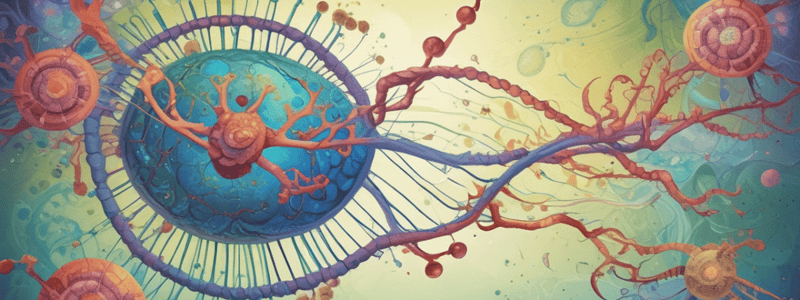Podcast
Questions and Answers
What is the primary function of RNA localization elements?
What is the primary function of RNA localization elements?
- To regulate gene expression through inhibition of protein synthesis
- To facilitate the degradation of mRNAs with specific sequences
- To enhance the translation of mRNAs with secondary structures
- To mediate the localization of mRNAs to specific regions within the cell (correct)
Which of the following is NOT a type of cytoskeleton involved in mRNA transport?
Which of the following is NOT a type of cytoskeleton involved in mRNA transport?
- Microfilaments
- Intermediate filaments
- Microtubules
- Centrioles (correct)
What is the primary function of RNA-binding proteins in mRNA localization?
What is the primary function of RNA-binding proteins in mRNA localization?
- To inhibit the translation of mRNAs with secondary structures
- To degrade mRNAs with specific sequences
- To act as adaptors, linking mRNAs to motor proteins or the cytoskeleton (correct)
- To facilitate the transport of mRNAs to the nucleus
Which of the following is an example of a subcellular region where mRNAs can be localized?
Which of the following is an example of a subcellular region where mRNAs can be localized?
What is the primary function of the cytoskeleton in mRNA trafficking?
What is the primary function of the cytoskeleton in mRNA trafficking?
What is the significance of subcellular mRNA distribution?
What is the significance of subcellular mRNA distribution?
What is the primary requirement for translation to occur in a cell?
What is the primary requirement for translation to occur in a cell?
In which organisms can mRNAs move to the daughter cell during budding?
In which organisms can mRNAs move to the daughter cell during budding?
Where can tRNAs and mRNAs be localized in all cells?
Where can tRNAs and mRNAs be localized in all cells?
In which stage of development do mRNAs move to a single pole of the syncytium?
In which stage of development do mRNAs move to a single pole of the syncytium?
What is responsible for covering mRNAs after transcription in the nucleus?
What is responsible for covering mRNAs after transcription in the nucleus?
What is the role of motors in mRNA transport?
What is the role of motors in mRNA transport?
During the anteroposterior differentiation of Drosophila, what is the characteristic of the gradients of proteins such as BCD or HB-M?
During the anteroposterior differentiation of Drosophila, what is the characteristic of the gradients of proteins such as BCD or HB-M?
In neurons, what is the purpose of mobilizing mRNAs to the zone of synaptic transmission?
In neurons, what is the purpose of mobilizing mRNAs to the zone of synaptic transmission?
What is the mechanism by which mRNAs are localized to specific poles in the Drosophila embryo?
What is the mechanism by which mRNAs are localized to specific poles in the Drosophila embryo?
In yeast cells, what is the outcome of differential mRNA transport before cell division?
In yeast cells, what is the outcome of differential mRNA transport before cell division?
What is the role of Bicoid protein in the localization of Caudal protein?
What is the role of Bicoid protein in the localization of Caudal protein?
What is the purpose of the localization of Hunchback protein to the anterior pole?
What is the purpose of the localization of Hunchback protein to the anterior pole?
What is the role of She2p or She3p proteins in S.cerevisiae?
What is the role of She2p or She3p proteins in S.cerevisiae?
What is the function of microtubules in mRNA transport?
What is the function of microtubules in mRNA transport?
What is the role of Puf3 protein in the localization of mRNAs?
What is the role of Puf3 protein in the localization of mRNAs?
In fibroblasts, what happens to mRNAs in response to a stimulus that induces cellular movement?
In fibroblasts, what happens to mRNAs in response to a stimulus that induces cellular movement?
Why are mRNAs localized to the vicinity of the mitochondria?
Why are mRNAs localized to the vicinity of the mitochondria?
What is the outcome of active mRNA transport in cells?
What is the outcome of active mRNA transport in cells?
What is the consequence of the inhibition of Hunchback protein translation by Nanos protein?
What is the consequence of the inhibition of Hunchback protein translation by Nanos protein?
What is the result of the localization of mRNAs to specific poles in the Drosophila embryo?
What is the result of the localization of mRNAs to specific poles in the Drosophila embryo?
Flashcards are hidden until you start studying
Study Notes
Spatial Localization of mRNAs
MRNA Trafficking
- The process of transporting mRNAs to specific locations within the cell
- Enables spatial regulation of gene expression, allowing for localized protein synthesis
- Important for cellular processes such as cell polarization, migration, and development
Cytoskeleton-mediated Transport
- The cytoskeleton provides a framework for mRNA transport
- Microtubules, microfilaments, and intermediate filaments are involved in mRNA transport
- Motor proteins (e.g. kinesin, dynein) travel along the cytoskeleton, carrying mRNAs to their destinations
RNA Localization Elements
- Specific sequences or structures within the mRNA that mediate its localization
- Can be found in the 5' or 3' untranslated regions (UTRs) or in the coding sequence
- Examples: zip code-like elements, localization elements with secondary structure
RNA-binding Proteins
- Proteins that bind to specific RNA sequences or structures, influencing mRNA localization
- Can act as adaptors, linking mRNAs to motor proteins or the cytoskeleton
- Examples: Staufen, ZBP1, and FMRP
Subcellular MRNA Distribution
- mRNAs can be localized to specific subcellular regions, such as:
- Dendrites in neurons
- Leading edge in migrating cells
- Apical or basolateral regions in epithelial cells
- Germ plasm in developing embryos
- Subcellular mRNA distribution is critical for proper cellular function and development
Studying That Suits You
Use AI to generate personalized quizzes and flashcards to suit your learning preferences.




